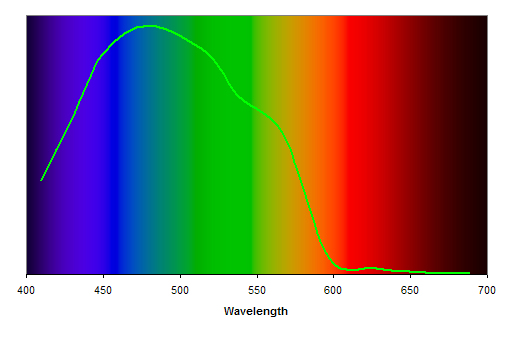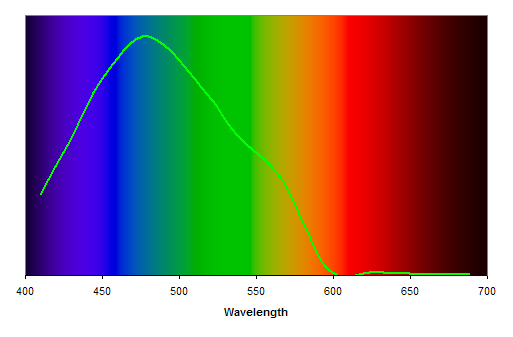
Figure 1: Spectrum for colour temperature of 6500K.
Most lamps made for the aquarium trade are rated by a colour temperature (e.g. 10000K, 20000K). Many manufacturers of those lamps also claim their lamps simulate the light found at certain depths on the reef. The reality is that not only do the lamps not closely simulate light at depth on the reef but there isn't even a relationship between colour temperature and light at depth.
Note this does not comment on the quality of the lamps or their suitability to the task, but simply that they will not simulate the spectra that would be encountered on the reef.
Colour temperature is used to describe the colour of "visible" or "white" light. It is based on the colour of light produced when a theoretical black body is heated to the indicated temperature in Kelvin. For example, full noon Sunlight has a colour temperature of around 5000K, which means that the colour of that light is close to the light given off by the theoretical black body heated to 5000K (~4727°C).
Figures 1-3 give examples of the theoretical spectra for 3 different colour temperatures. The lines in the graph indicate the relative amount of each wavelength present at that colour temperature. The colours in the background indicate the approximate colours for the different wavelengths. At 6500K, the proportion of each wavelength is quite similar, with slightly more shorter wavelength light (towards 400 nm). As the colour temperature increases, the proportion of short wavelength light increases and long wavelength decreases.

Figure 1: Spectrum for colour temperature of 6500K.

Figure 2: Spectrum for colour temperature of 10000K.

Figure 3: Spectrum for colour temperature of 20000K.
For more information on colour temperature, see: Color Temperature.
Light is absorbed and scattered as it passes through water. Different wavelengths of light are affected at different rates resulting in a change in spectra with depth. Blue light is affected the least with red light affected the most. Water clarity affects the rate of light loss and also changes the rate of loss of each wavelength.
Figures 4-7 show spectra at 4 depths based on data collected by Dustan (1982) at Dancing Lady Reef, Discovery Bay, Jamaica, West Indies on an average sunny day at local apparent noon.

Figure 4: The spectrum of light at the surface (After Dustan, 1982).

Figure 5: The spectrum of light at 10 m. (After Dustan, 1982).

Figure 6: The spectrum of light at 20 m (After Dustan, 1982).

Figure 7: The spectrum of light at 30 m. (After Dustan, 1982).
As can be seen, the spectra of light at depth on a reef does not closely follow the spectra for "white" light at all. As the colour temperature increases, the spectra shift towards shorter wavelengths. With increasing depth, the spectra don't shift, but rather the peak around 540 nm (blue/green) gets stronger. Figure 8 shows a comparison between 10 m and 10000K.

Figure 8: Spectra at 10m and colour temperature of 10000K. (After Dustan, 1982).
Most artificial lighting, especially fluorescent and metal halide, do not simulate black body radiation. This means the spectra of these lamps will not resemble the spectra shown above and they should be rated with a correlated color temperature. This makes it difficult to compare spectra of artificial lighting to those of natural lighting. Even so, there will still be some correlation between the spectrum of the lamp and the rated colour temperature.
Given that light at depth does not correlate with black body radiation, claims that 10000K or 20000K light simulates natural light at depth is not accurate. Also, the correlation between the spectra for the lamps and black body radiation is not always close.
At best, artificial lamps can only very roughly approximate either light at depth or the specified colour temperature but not both. At worst, they don't approximate either.
As stated above, none of this discussion takes anything away from the quality of the lamps on offer. It merely highlights that the claims of simulating natural light are generally inaccurate. Hobbyists should not base their purchase decisions on those claims, thinking that their corals and other inhabitants will do better because the lamps simulate natural light. In reality, corals and other organisms requiring light are not all that fussy when it comes to the colour of the light and choice boils down to the personal preference of the hobbyist.
Dustan P. 1982. Depth-dependent photoadaption by zooxanthellae of the reef coral Montastrea annularis.. Mar. Biol. 68:253-264.
Last updated: October 14, 2006